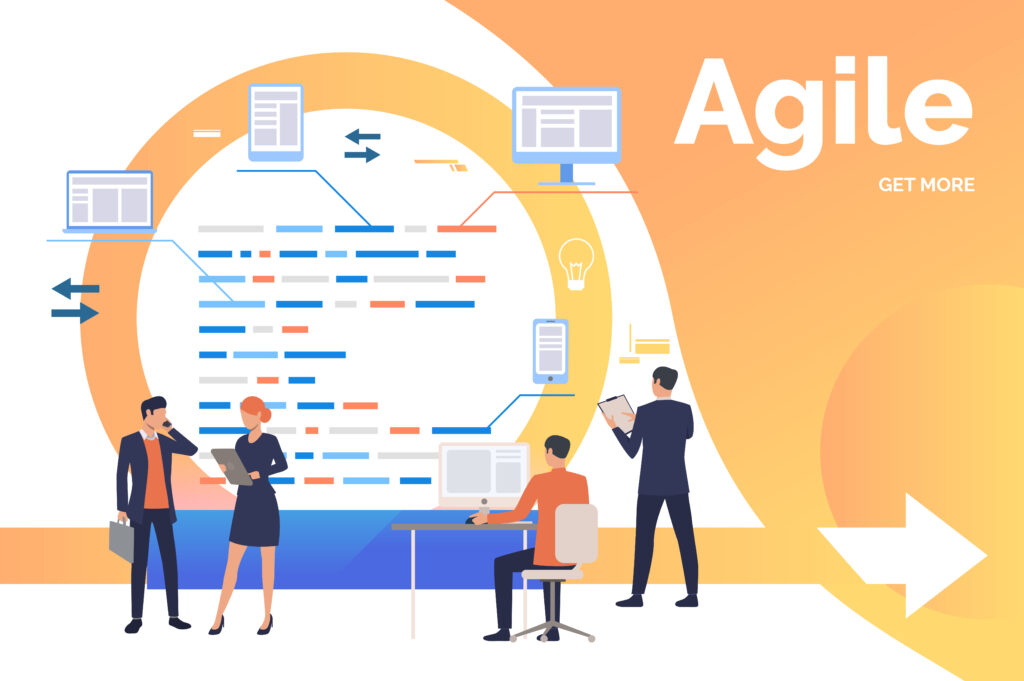
Introduction:
Timely and actionable insights are critical in the fast-paced corporate world. Organizations are increasingly using Agile approaches to transform their Business Intelligence (BI) processes in order to stay up with changing market conditions. This thorough reference explains how to incorporate Agile ideas and practices into business intelligence (BI) processes to improve flexibility, teamwork, and the efficacy of data-driven decision-making as a whole.

Understanding Agile in the Context of Business Intelligence
1. Agile Principles in BI:
- Iterative Development: Divide big-data initiatives into more manageable steps so that they can be continuously improved upon in response to input.
- Customer Collaboration: Involve stakeholders at every stage of the BI development process to make sure the insights provided are suitable for their changing requirements.
- Accepting Change: To adjust to changing business priorities, accept requirements changes even if they occur late in the development process.
- Self-Organizing Teams: To boost productivity and group ownership, BI teams should be encouraged to collaborate across functional boundaries.
2. Agile Methodologies for BI:
- Scrum in BI: To arrange BI teams, schedule sprints, and guarantee the constant delivery of insightful BI information, use Scrum frameworks.
- Kanban for BI: Use Kanban boards to effectively prioritize tasks and promote transparency by managing and visualizing the flow of BI activity.

Applying Agile to Business Intelligence Practices
1. User Story Mapping:
- Define User Stories: Using user stories, map important user personas BI requirements and make sure they are in line with corporate objectives.
- Prioritize User Stories: Sort user stories according to their business value so that BI teams can concentrate on delivering the most significant insights first.
2. Sprint Planning for BI:
- Define Sprint Goals: Clearly define the goals of every BI sprint, including improving current reports and creating new analytical models.
- Time-Boxed Development: To maintain a responsive development speed and a consistent cadence of BI deliverables, apply time-boxed sprints.
3. Cross-Functional BI Teams:
- Skill Diversification: Create diversified, cross-functional BI teams of data analysts, business analysts, and visualization specialists.
- Collaborative Environment: Encourage a culture of collaboration among team members so that during the BI development process they may exchange ideas, knowledge, and criticism.
4. Continuous Feedback Loops:
- Regular Stakeholder Demos: Showcase BI deliverables on a frequent basis, solicit comments, and make any necessary modifications in real time.
- Retrospectives: Have retrospectives following each BI sprint to discuss what went well and what may be improved, promoting a continuous improvement culture.5. Agile BI Tools:
- Data Visualization Platforms: Use agile-friendly BI tools, such Tableau or Power BI, to speed up the development and visualization of insights.
- Collaboration Platforms: Jira and Trello are examples of collaborative applications that may be used to organize BI activities, improve collaboration, and preserve transparency.

Overcoming Challenges in Applying Agile to BI
1. Data Quality and Governance:
- Establish Data Standards: By establishing and following defined data procedures, you can guarantee data quality and control.
- Data Validation: In order to identify anomalies early in the BI development lifecycle, implement automated data validation procedures.
2. Balancing Flexibility and Structure:
- Adaptability: To keep BI projects from becoming chaotic, embrace Agile’s adaptable nature while preserving a certain degree of structure.
- Agile Leadership: Encourage leadership that recognizes the necessity for strategic alignment while also understanding the balance between Agile ideals.
3. Cultural Shift:
- Training and Education: BI teams and stakeholders should be encouraged to adopt an Agile attitude by funding training and educational initiatives.
- Change Management: To help the organization navigate the cultural transition to Agile BI practices, put change management techniques into action.
Conclusion:
Organizations may unleash the full power of their data by integrating Agile concepts and methodology with Business Intelligence practices. Agile‘s iterative, customer-centric methodology improves teamwork, speeds up delivery, and makes ensuring that business requirements are always evolving so that BI insights stay applicable. Accept the Agile intelligence revolution and turn your business intelligence (BI) procedures into a responsive, dynamic engine that powers data-driven decision-making.








